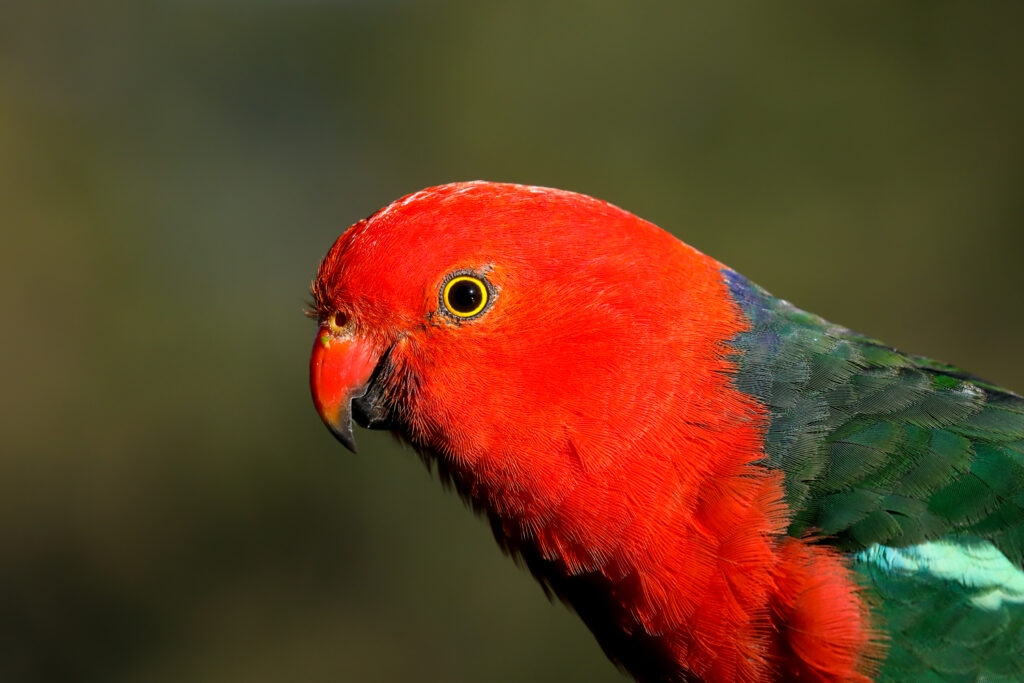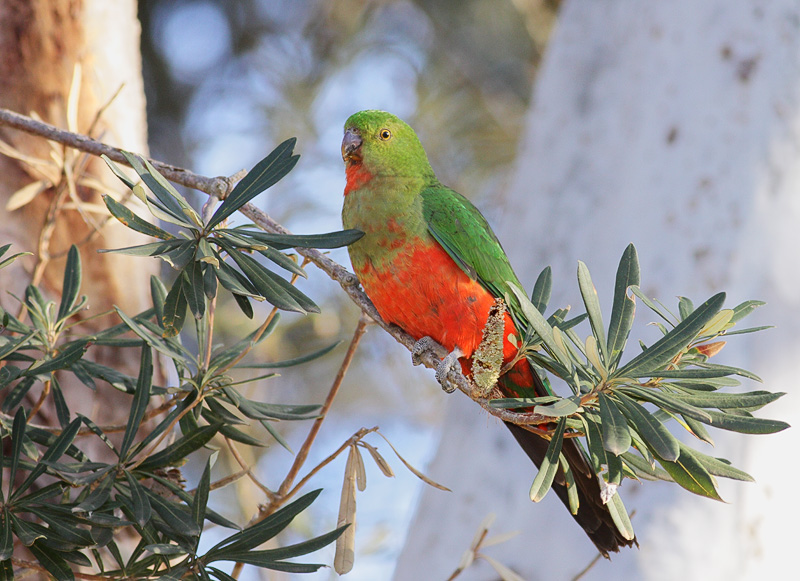When people occasionally ask me ‘what is my favourite bird?’ I am stumped! However, I could say that the parrot family is chock full of favourites! The diminutive but super intelligent Budgerigar. The gentle and endearing Gang-gang Cockatoo. The spirited thug-life vibes of the Sulphur-crested Cockatoo or the calm slow elegance of a small family of Yellow-tailed Black-cockatoos wafting over the pines. The chattering calls and incredible colours of Crimson Rosellas. And one parrot that never fails to delight the soul is the Australian King-parrot!

A gorgeous portrait of a male Australian King-parrot – by Patrick Kavanagh from Flickr via Wikimedia commons.
Decked out in Christmas-worthy bold red and bright green, King-parrots are the only Australian parrot with a red head. Females have green heads but the same stunning red colour on their bellies. Young birds are mainly green like the females, but you may see a patchy red and green bird as young males acquire their adult plumage by a slow moult, which begins when the bird is over fifteen months old and is not completed for a further twelve months.
When I looked up Australian King-parrot in my Handbook of Australian New Zealand and Antarctica Birds (HANZAB) I was surprised to see how little is known (at the time of publication in the 90s) of the migratory movements, social organisation and breeding habits of this striking bird. They are difficult to study and much of what is known is from studies of pairs in captivity.
Up until the last ten years, King-parrots were rarely seen in our region. I saw a small flock on Mount Macedon once, a small flock at Moorabool Reservoir and a pair munching on the cherry tomatoes at Garden of St Erth, Blackwood. Each very notable sightings!
Ballarat Courier nature writer Roger Thomas and ornithologist Jack Wheeler published a book in 1983 called Birds of the Ballarat Region and in this book the Australian King-parrot is described as being ‘very rare – only a few sightings” in Daylesford and Eganstown, and noted that two birds were seen in Waterloo in 1971.
Well, one only need to hop onto social media to see that Australian King-parrots are well and truly HERE in the Daylesford region, including Bullarto, Daylesford, Glenlyon and near my home in Porcupine Ridge too! They are nervous in the wild forest situation, flying away swiftly, calling their distinctive chiming alarm call. But these lovely parrots have learned to beg for food and people can’t seem to get enough of feeding (and photographing) these friendly and beautiful birds!
The Aussie Bird Count team at BirdLife Australia crunched their data from 2014 – 2021 and revealed that numbers of king-parrots are increasing in Melbourne. This follows the same pattern of king-parrots increasing sevenfold(!) in Canberra since 1981, an increase which has now has now levelled off. It seems that Australian King-parrots have adapted to life in well treed suburbs across their range. Their numbers have grown from their ability to feed on the fruit, nuts and seeds grown in people’s gardens and possibly also due to artificially provided food.
Feeding wild parrots seed is not a good idea. You are not helping your beloved parrots by doing so! Sunflower seeds are extremely rich and would be similar to a human gorging on nothing but caramel slices or Portuguese tarts. Feeding stations attract Sulphur-crested Cockatoos, which often then vandalise nearby houses and properties. Young King-parrots are more likely to take seed as an easy meal, and thus miss out on the complex nutritional profile of naturally occurring fruits seeds, flowers and insects. Finally, and possibly mots importantly – feeding stations can spread diseases such as beak and feather disease, and spironucleosis. Both of these diseases are nasty wasting diseases that are incurable!
If you want to care for your local King-parrots – start planting! They love ground covers such as Dianella, Climbing Satlbush (Einadia nutans), a variety of ferns and sedges. They also like shrubs such as Sticky Hop-bush (Dodonea viscosa) and Hazel Pomaderris (Pomaderris aspera). King-parrots usually visit houses in tall forest areas and are attracted particularly to the tall wattles and eucalypts. I have also heard they really enjoy cherry tomatoes – both ripe and green. So perhaps instead of feeding your local lovelies you could leave a few cherry tomatoes on the vine for them.

Young male King-parrot – note the red around the head – the females’ heads are purely green. Photo by Leo from Flickr via Wikimedia commons.
Thanks, nicely worded article and beautiful photos.
Good advice too on their diet requirements.
Parrots are indeed coming back to the suburbs,
I just saw a very rare albino black cockatoo in a park
around here !
Thanks for your kind comments Pierre! Wow – an albino black cocky – that would be an amazing sight!
Love it Tanya, well done. No feeding! Just a place to drink.
The Kites have flown the nest.
Fingers crossed for next year.
Thanks for reading Charlie : ) yes it looks like the kites have found a wonderful regular nesting place with you both!
Love these creatures, thank you for putting the time in writing such a great article, including planting advice.
And thank YOU Greg for reading! I was surprised they liked ground cover plants : )